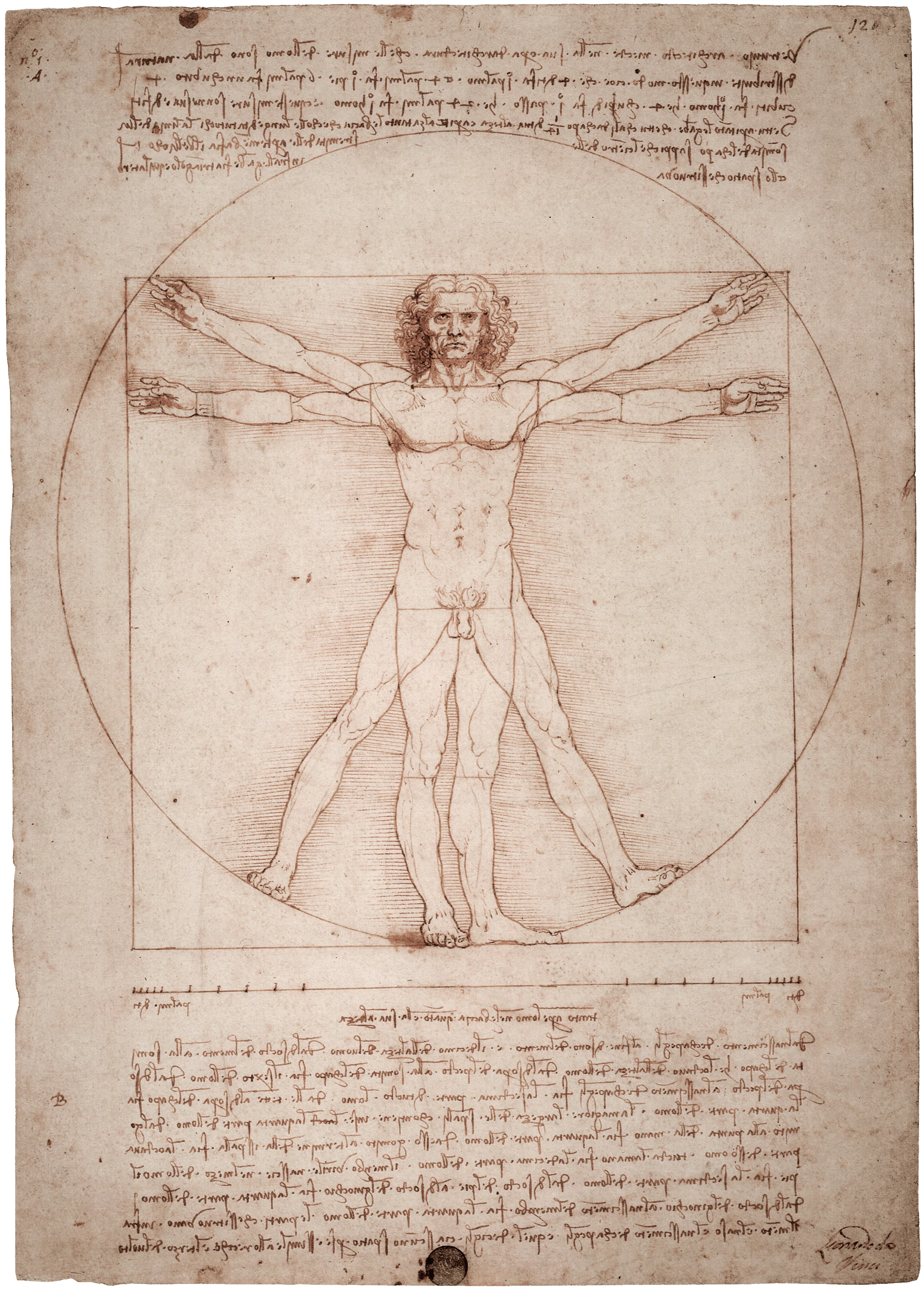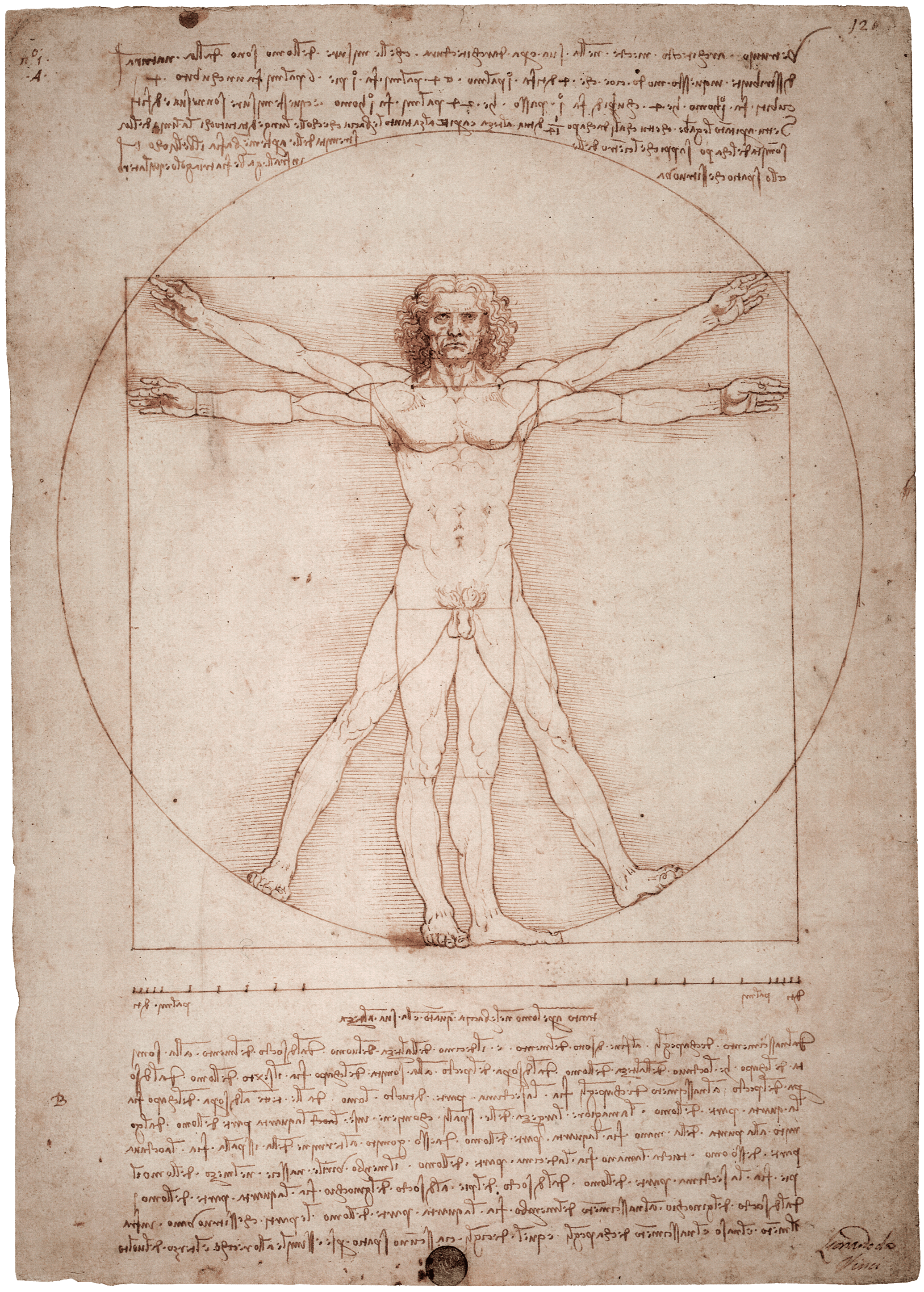


The Vitruvian man is an odd candidate for the most famous drawing in the world. It’s small in scale, monochrome, carefully drawn on a page just over a foot tall. As far as Da Vinci’s immense oeuvre goes, it’s one of innumerable sketches—an elegant but apparently simple visual experiment. The cult of personality that has developed around Da Vinci’s genius is persuasive in itself, but this drawing exudes an undeniable magic all its own. We're going to go deep on the history and background of the Vitruvian Man, but first, let’s look at a few reasons why this little drawing has held a place in the public consciousness for centuries:
It’s tempting to suggest that the Vitruvian man is a self-portrait by Leonardo Da Vinci. After all, the artist was in his late 30s when he made the sketch, and the figure’s wavy hair and strong cheekbones do resemble another possible self-portrait by the artist, the Portrait of a Man in Red Chalk. Another option is that the Vitruvian man was a local corpse. Da Vinci often attended and performed dissections of the diseased, sometimes executed criminals, sometimes those dead by natural causes. In 2011, Dr. Hutan Ashrafian, a physician at the Imperial College of London, suggested that a slight bump visible above the left side of the figure’s groin looked suspiciously like an inguinal hernia, which would have been sufficient to kill its owner, putting them in line to model for this famous drawing.
In 2018 author and educator Ashish Jaiswal noted in his book ‘Fluid,’ that the encyclopedic text Vishnudharmottara Purana included dimensions for the perfect human form, leading to provocative articles questioning if India should get credit for the Vitruvian Man. The Citraśikhaṇḍa section of the Vishnudharmottara, specifically Khanda (chapter) 3, Adhyay (verse) 35 does break down an elaborate system of measurements across 5 ideal body types based on the width of the human finger, aiming to codify a systematic beautify standard for the creation of religious imagery. But according to historian and translator Stella Kramrisch, the text dates from between 200 and 400 CE, making it several hundred years more recent than Vitruvius’s measurement system. But you know what, it’s not a competition, and the Vishnudharmottara provides an glimpse into the artistic practices of Gupta-era artwork, and its English translation is available for free—check it out!
Short answer? No! Many ratios are described in Vitruvius’s original writings, with some adaptations introduced by Da Vinci, but the most common claim is that the ratio of radius of the circle to the height of the square is the golden ratio of 0.618··· But assumptions like this often die at the hands of academic scrutiny, and thanks to painstaking analysis by Takashi Ida, Professor of Material Science at the Nagoya Institute of Technology, we know the radius to height ratio is something between 0.606 ∼ 0.609. Going even further down the rabbit hole, Edwin Westhoff, photographer and inventor of the “Diagonal Method” of compositional analysis concluded that the integer-based fractions defined by Vitruvius and explored by Da Vinci in no place used or even coincided with the golden ratio. Sorry Dan Brown.
Eight or so years after the creating the Vitruvian Man, Da Vinci did work with the golden ratio while illustrating “Divina proportione” for his friend, the mathematician Luca Pacioli. The treatise explores the golden ratio both mathematically and spiritually, and for its appendix, Da Vinci created the first representations of skeletal solids, providing views of both the font and back of the geometric forms. Cool stuff.
As a prolific engineer, draftsman, and occasional architect, Leonardo da Vinci dutifully studied the landmark text describing and defining the architectural methods of Classical Rome, De Architectura, by the architect, and this image’s namesake: Vitruvius. Vitruvius lived 1500 years before Leonardo, but even at a millennia and a half old, De Architectura was still a landmark text at the time of the Italian Renaissance, with a massive influence over neoclassical architecture. The notes above and below the Vitruvian figure are Leonardo’s own translation and paraphrasing of a key passage from De Architectura. The upper part of the inscription is a paraphrasing of Vitruvius:
“Vetruvio, architect, puts in his work on architecture that the measurements of man are in nature distributed in this manner: that is a palm is four fingers, a foot is four palms, a cubit is six palms, four cubits make a man, a pace is four cubits, a man is 24 palms and these measurements are in his buildings. If you open your legs enough that your head is lowered by one-fourteenth of your height and raise your hands enough that your extended fingers touch the line of the top of your head, know that the centre of the extended limbs will be the navel, and the space between the legs will be an equilateral triangle.”
The lower inscription lists the proportions that govern the image:
“The length of the outspread arms is equal to the height of a man; from the hairline to the bottom of the chin is one-tenth of the height of a man; from below the chin to the top of the head is one-eighth of the height of a man; from above the chest to the top of the head is one-sixth of the height of a man; from above the chest to the hairline is one-seventh of the height of a man. The maximum width of the shoulders is a quarter of the height of a man; from the breasts to the top of the head is a quarter of the height of a man; the distance from the elbow to the tip of the hand is a quarter of the height of a man; the distance from the elbow to the armpit is one-eighth of the height of a man; the length of the hand is one-tenth of the height of a man; the root of the penis is at half the height of a man; the foot is one-seventh of the height of a man; from below the foot to below the knee is a quarter of the height of a man; from below the knee to the root of the penis is a quarter of the height of a man; the distances from below the chin to the nose and the eyebrows and the hairline are equal to the ears and to one-third of the face.”
“By the ancients man has been called the world in miniature; and certainly this name is well bestowed, because, inasmuch as man is composed of earth, water, air and fire, his body resembles that of the earth.”
In Da Vinci’s era there was no real line between science, religion, and mathematics. The quote above, from Da Vinci’s 1492 notebook, captures one of the most pervasive philosophical principles of the Renaissance, that understanding the systems of the human body could provide insight into the mechanics of the universe itself.
Vitruvius’s writings were printed for the first time since their ancient authorship in 1486, by Giovanni Sulpizio da Veroli in Rome, setting off a fervor of excitement and study among Renaissance scholars—in part because of their relation of architecture to the human form. So the Vitruvian Man was a sort of science experiment for Da Vinci, an attempt to visualize and improve on a relatively well-known theory of ideal proportion. And while Da Vinci was seeking knowledge, it probably wasn't a secret. Da Vinci’s close friend, the architect Giacomo Andrea, drew an interpretation of Vitruvius’s proportions first, probably inspiring Da Vinci. And while Da Vinci’s take on the problem is elegant, the tension between ideal mathematics and actual human proportion peppers the work. Da Vinci used only half of Vitruvius’s listed proportions, and modified those to better align to his own understanding of human anatomy. Even with adjustments, parts of the Vitruvian Man are slightly stretched or compressed to fit the geometric mold—a sort of “what if” on the part of Leonardo, after all, who’s really to say what the ‘ideal’ human body is?
While the philosophical belief that human construction mirrored the cosmos was prevalent in the Renaissance, the adage “as above, so below” has more recently been adopted by esoteric thinkers, making the Vitruvian Man the subject of decades of speculation by a diverse array of fringe theorists. This rabbit hole goes deep, so I’ll hit some highlights. Historian and author Roberto Concas claims to have uncovered an algorithm of divine proportion used by the renaissance Church to authenticate artworks “just like a Blockchain.” Shamanic Healer Luke Miller claims that the square represents the masculine and the circle the feminine, making the Vitruvian Man a symbol of perfect balance between the two. Allen Rubin, author of “Guide to Using Research for Evidence-Based Practice” also wrote “The Da Vinci Man Code” boasting 400 illustrations proving that the Vitruvian Man is a universal code to improve communication, love, wealth, health and spiritual growth.
But among the eager interpreters, one in particular stands out to me. C. Lance Harding, Ph.D in Philosophy and Art History, has gone deeper than anyone I've yet seen into the mysteries of the Vitruvian Man—by evolving them. While many esoteric scholars look to Da Vinci’s Vitruvian Man as a source for encoded wisdom, Harding went wider, supplementing Vitruvius with the writings of the Benedictine monk Desiderius Lenz, Egyptologist Karl Lepsius, and the sculptures of the ancient Greek sculptor Polyclitus, developing an entirely new analysis of the human proportion. And isn't that what Leonardo did? Engage with the old, but adapt it based on personal expertise. I think Da Vinci'd be proud of those endlessly curious few who measure, theorize, draw, and search for truth.
...
Got questions, comments or corrections about The Vitruvian Man? Join the conversation in our Discord, and if you enjoy content like this, consider becoming a member for exclusive essays, downloadables, and discounts in the Obelisk Store.
